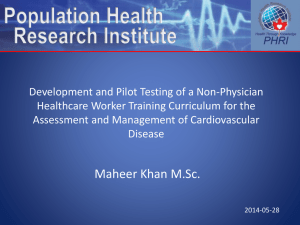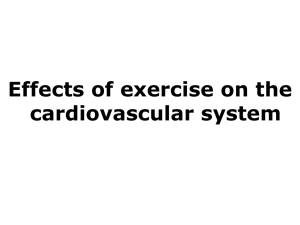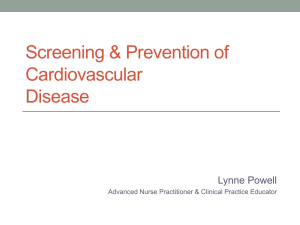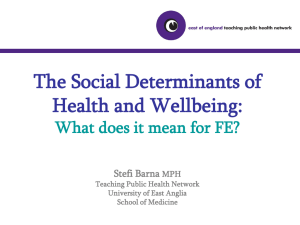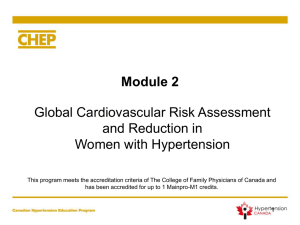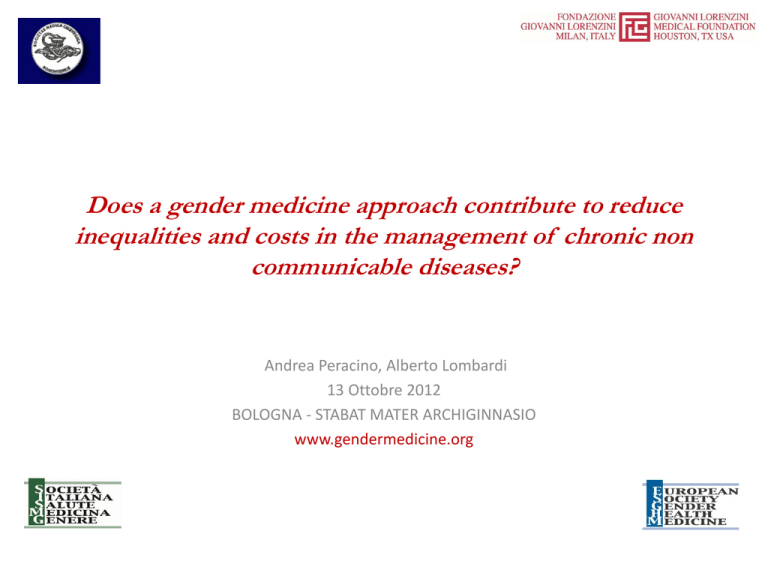
Does a gender medicine approach contribute to reduce
inequalities and costs in the management of chronic non
communicable diseases?
Andrea Peracino, Alberto Lombardi
13 Ottobre 2012
BOLOGNA - STABAT MATER ARCHIGINNASIO
www.gendermedicine.org
How much high is the economic burden on NHSs derived from a
limited knowledge on and a non appropriate medical approach to,
gender inequalities?
Quality of Life Index
www.economist.com
2005
•
•
•
•
•
•
•
material well being
health
family relations
job security
social and community activities
political freedom and security
gender equality
2010
•
•
•
•
•
•
•
•
•
cost of living
culture and leisure
economy
environment
freedom
health
infrastructure
safety and risk
climate
Figure 1
Life expectancy in countries in the WHO European region, 2010
(or latest available data) Data from WHO health for all database
Source:The Lancet 2012; 380: 1011-1029 (DOI:10.1016/S0140-6736(12)61228-8)
Terms and Conditions
Figure 1
Life expectancy (LE) and healthy life years
(HLYs) at 50 years of age (all EU countries)
Source The Lancet 2008; 372: 2124-2131
Deaths for Men in Europe
Deaths for Women in Europe
EHN-ESC European Cardiovascular Disease Statistics 2012
Deaths < 65 for Men in Europe
Deaths < 65 for Women in Europe
EHN-ESC European Cardiovascular Disease Statistics 2012
Disability-adjusted life years lost by cause, 2002, Europe
in men
in women
EHN-ESC European Cardiovascular Disease Statistics 2012
Figure 9
Female unemployment rates in
selected European countries by age, 2011
Data from the Labour Force Survey
The Lancet 2012; 380: 1011-1029 (DOI:10.1016/S0140-6736(12)61228-8)
Terms and Conditions
Figure 10
differences between women
and men in healthy life
years, years not in good
health and life expectancy at
birth in selected European countries
Data from the Eurostat database.
2008 data for Italy and UK.
The Lancet 2012; 380: 1011-1029 (DOI:10.1016/S0140-6736(12)61228-8)
Terms and Conditions
Total numbers of deaths by cause and sex, Europe
(European Cardiovascular Diseases Statistics 2012)
Men
Women
Total
Coronary Heart Disease
356.366
324.984
681.350
Stroke
191.784
272.140
463.924
Other CVD
321.660
443.920
765.580
Stomach cancer
36.552
23.962
60.514
Colo-rectal cancer
78.561
66.141
144.702
Lung cancer
184.354
73.675
258.029
897
89.953
90.850
201.613
176.692
378.305
Breast cancer
Respiratory disease
prevalence of smoking, boys aged 15 years,
2009/10, Europe
EHN-ESC European Cardiovascular Disease Statistics 2012
prevalence of smoking, girls aged 15 years,
2009/10, Europe
EHN-ESC European Cardiovascular Disease Statistics 2012
change in smoking rates among 15 year olds,
by sex, 1993/94 to 2009/10, Europe
EHN-ESC European Cardiovascular Disease Statistics 2012
proportion of 11 year olds participating in 1 hour or more of MVPA per
day, by sex, 2009
EHN-ESC European Cardiovascular Disease Statistics 2012
proportion of 13 year olds participating in 1 hour or more of MVPA per
day, by sex, 2009
EHN-ESC European Cardiovascular Disease Statistics 2012
proportion of 15 year olds participating in 1 hour or more of MVPA per
day, by sex, 2009
EHN-ESC European Cardiovascular Disease Statistics 2012
proportion of 11 year olds watching 2 or more hours of television per day,
by sex, 2009, Europe
EHN-ESC European Cardiovascular Disease Statistics 2012
proportion of 13 year olds watching 2 or more hours of television per day,
by sex, 2009, Europe
EHN-ESC European Cardiovascular Disease Statistics 2012
proportion of 15 year olds watching 2 or more hours of television per day,
by sex, 2009, Europe
EHN-ESC European Cardiovascular Disease Statistics 2012
percentage of total healthcare expenditure on
CVD in the EU, 2009, by resource use category
EHN-ESC European Cardiovascular Disease Statistics 2012
total cost of CVD, CHD and Cerebrovascular diseases, 2009, EU
EHN-ESC European Cardiovascular Disease Statistics 2012
CVD
CHD
Cerebrovascular Disease
€ mio
% of total
€ mio
% of total
€ mio
% of total
Direct Health care
costs
106,157
54%
19,868
33%
19,102
50%
Productivity loss
due to mortality
26,963
14%
12,014
20%
4,812
13%
Productivity loss
due to morbidity
18,874
10%
5,530
9%
3,329
9%
Informal care costs
43,560
22%
22,812
38%
11,116
29%
Total
195,554
60,225
38,360
direct health care costs in some country
cost of CVD, CHD and Cerebrovascular
diseases, 2009
EHN-ESC European Cardiovascular Disease Statistics 2012
CVD
CHD
Cerebrovascular Disease
€ mio
cost per
capita
% of
total
€ mio
cost
per
capita
%
of
total
€ mio
cost
per
capita
% of
total
Italy
14,488
€241
10%
2,572
€43
2%
2,706
€45
2%
France
12,731
€198
6%
1,682
€26
1%
1,530
€24
1%
Germany
30,679
€374
11%
5,414
€66
2%
5,963
€73
2%
Spain
7,935
€173
8%
1,463
€32
1%
1,067
€23
1%
UK
9,636
€156
6%
1,997
€32
1%
1,979
€32
1%
indirect health care costs in some country cost of CVD, CHD and
Cerebrovascular diseases, 2009, € mio (* estimated)
EHN-ESC European Cardiovascular Disease Statistics 2012
CVD
CHD
Cerebrovascular Disease
Product.
losses due
to
mortality
Product.
losses due
to
morbility
Informal
care
Product.
losses
due to
mortality
Product.
losses due
to
morbility
Informal
care
Product.
losses due
to
mortality
Product.
losses due to
morbility
Informal
care
Italy
2,097
1,810*
6,865
862
430*
3,468
392
460*
640*
France
2,049
2,482
3,153
690
904
2,201
418
456
858
Germany
7,584
5,659
14,501
3,332
1,381
7,492
1,124
694
4,121
Spain
1,369
940
4,899
588
244
2,242
264
211
860
UK
4,466
2,715
4,215
2,474
1,022
1,915
702
354
1,118
cost/benefit ratio in prevention
Cardiovascular model: popultion attribuable risk -PAR
diet and physical activity PAR =32,8%
apo B/apo AI ratio PAR = 12,5%
weigh/hip ratio PAR 5,0%
blood pressure PAR =1,8%
global PAR = 52,1%
cost/benefit ratio in prevention
Cardiovascular model: primary and secundary prevention
In the last ten years it has been observed (*) :
An increase of percentage of physycal activity in women (from 29,5 to 30,8%)
and a decrease in men (from 33,5 to 32,9%).
An increase of statin use in men 45-54 year old (from 2,5% to 16,8%) and in
women after 65 year old (from 1,9% a 13,5%). The increase after 65° year of
life in men went from 1,9% to 38,9 % and from 3,5% to 32,8% in women.
The statin use in both gender between 45 and 60 year of life is under the primary
prevention reccomandation (NEJM 2010; 362: 2150-1).
(*) Centers for Disease Control and Prevention- CDC (NEJM 2010; 362: 2155-65)
cost/benefit ratio in prevention
HPV vaccination model
The cost in Italy of HPV related disease is estimated to be between € 200 and €
250 million per year, of which € 210 million are absorbed by the screening
and treatment of precancerous lesions and cancer of the cervix (Francesco Mennini:
Vaccine 2009; 27: A54-A61).
Using the Markov’s model it has been possible to estimate the threshold of
affordability for vaccination which is 9,569 and 26,361 per Quality Adjusted Life
Year - QALY gained respectively by the use of bivalent or quadrivalent vaccine
The value for the quadrivalent vaccine (which is also valid for genital warts)
allows a reduction of expenditure to 68.6% (€ 140-170 miliardi)
In terms of lives is calculated a reduction of 63,3%, 1.432 new cases of cervical
cancer and 513 deaths, compared to using only screening (Francesco Mennini
:Gynecologic Oncology 2009; 112:370.76)
cost/benefit ratio in prevention
Are gender bias in the National Health Systems approach to women MI?
Are the two days more in Intensive Care Units stay of women modifying the
cost/return ratio from DRG?
Are the stents use in women (NEJM 2007; 356: 898-1009 e Circulation 2007; 115: 833-39)
raising questions on women specific protocols?
cost/benefit ratio in prevention
Pharmaceutical research
The alarm raised in 2000 (NEJM 2000; 343: 475-80) and 2001 (JAMA 2001; 286: 70813), on the minor presence of women in the development and
risk/effectiveness trials of many drugs is still unsatisfied.
cost/benefit ratio in prevention
Pharmaceutical research
After years the representation of women is fairly over the 30% of enrolled
subjects. In American Heart Association studies it is shown that sex-specific
results were discussed in only 31% of primary trial publications. Women
accounted for 53% of all individuals with hypertension, 50% with diabetes,
51% with heart failure, 49% with hyperlipidemia and 46% with coronary
artery disease. By contrast the representation of women in the analyzed trials
is higher than the average among trials in hypertension (44%), diabetes (40%)
and stroke (38%) and lowest for heart failure (29%), coronary artery disease
(25%) and hyperlipidemia (28%).
Enrollment of women in randomized clinical trials has increased over time
but remains low relative to their overall representation in disease
populations. Efforts are needed to reach a level of representation that is
adequate to ensure evidence-based gender-specific recommendations.
Circ Cardiovasc Qual Outcomes. 2010; 3: 135-42.
gender challenge
Years ago a “gender challenge” has been launched by WHO to nations and
international organizations. The call was for: a better appreciation of risk
factors involving women’s health; the development of preventive
strategies to lessen the impact of diseases that disproportionately plague
older women (e.g., coronary heart disease, osteoporosis and dementia);
an increased emphasis on understanding why men die sooner than
women (World Health Organization, 1998, The World Health Report 1998, Geneva).
the burden of NCD and BD
With the claim “Stop the global epidemic non communicable disease“ the
WHO was launching its strategic “2008-2013 Action Plan for the Global Strategy
for the Prevention and Control of non-communicable Diseases” drawn up by
the Secretariat as requested by the Health Assembly in resolution WHA60.23.
The aim was to work in partnership to prevent and control the 4 noncommunicable diseases - cardiovascular diseases, diabetes, cancers and
chronic respiratory diseases and the 4 shared risk factors - tobacco use,
physical inactivity, unhealthy diets and the harmful use of alcohol.
Unfortunately WHO is missing the fifth common risk: the indoor and
outdoor pollution! The increase of urbanization channels the five risk factors in
an even more explosive melting pot of injury to the human health.
the burden of NCD and BD
Major chronic non-communicable diseases (NCDs) - primarily
cardiovascular disease (CVD), cancer, chronic obstructive pulmonary
disease (COPD) and diabetes - are responsible for 85% of the deaths and
70% of the burden of disease in Europe.
Atherosclerosis Supplements 2009; 10: 1-30
The Disorders of the Brain -BD in Europe are responsible for around 15,8
million DALYs (26,6% of global DALYs) in the population aged > 15 age: 7,3
million for men (23,4%), 8,5 million for women (30,1%).
H.U. Witchen, F. Jacobi et alii European Neuropsychopharmacology 2011; 21: 655–679.
33
size and burden of Mental Disorders
and other Disorders of the Brain in Europe 2010
(H.U.
Witchen, F. Jacobi et alii European Neuropsychopharmacology 2011; 21: 655–679)
34
the burden of NCD and BD
The economic burden (direct and indirect costs) of BDs in
Europe of € 798 billion/year exceeds the € 200 billion spent to
manage cardiovascular disease and the 150 billion spent on
cancer management (Eur Neuropsychopharmacology 2011; 21 (10): 718-79)
the burden of NCD and BD
While the effect of gender, age and cultural behavior on the health
both of women and men has been widely studied, attention to the
impact of the gender differences on the patho-physiology and,
therefore, on the management of the most common social diseases
such as the group of chronic Non Communicable Diseases (NCD) (e.g.
cardiovascular disease, diabetes, obesity, chronic obstructive pulmonary diseases and some
tumors) and the group of Brain Disorders (BD) (e.g. dementias, depression,
anxiety and mood disorders, to list a few) is both needed and lacking




